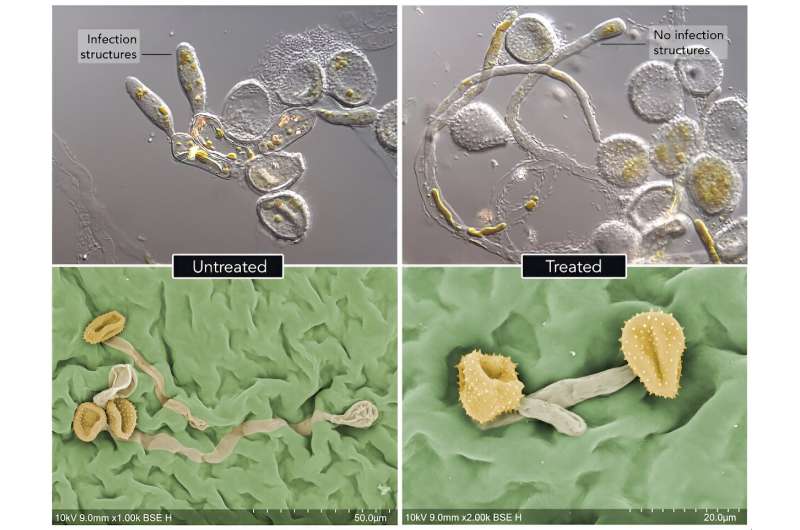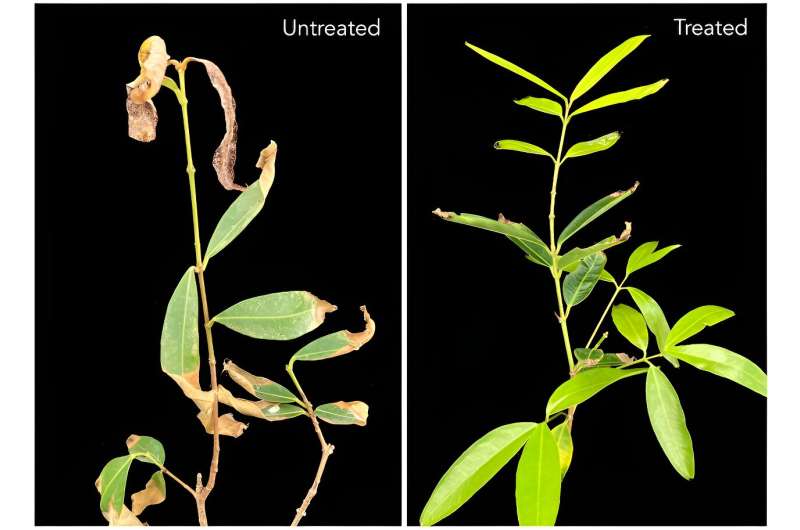One- to two-year-old Syzygium jambos trees (n = 6) grown in a greenhouse were treated with nuclease-free H.2O (negative control), a nonspecific dsRNA control (green fluorescent protein (GFP)), or a dsRNA beta-tubulin specific for A. psidii (β-TUB), or transcription elongation factor (EF1-a) at 100 ng/μL and challenged with inocula of urediniospores of A. psidii 48 h after dsRNA treatment. Disease was assessed two weeks after inoculation. a Comparison of photos of S. jambos trees, one from each treatment group and control group. Control -dsRNA and GFP trees showed severe myrtle rust symptoms, while plants treated with EF1-a and β-TUB showed significantly reduced symptoms. The photos were taken two weeks after inoculation. Credit: Communication biology (2023). DOI: 10.1038/s42003-023-05618-z
About ten years ago, an invasive fungal disease called myrtle rust reached Australia and began spreading like a plague to some plants. The disease affects plants in the Myrtaceae family, which includes eucalyptus, paperbark and lilly pillies, and accounts for 10% of Australia’s plant biodiversity.
In just a few years, myrtle rust has altered ecosystems, destroying trees and their canopies, wiping out entire species in some areas, and economically impacting industries that grow trees such as lemon-scented myrtle and the tea tree.
The disease is a slow-moving ecological wrecking ball: surveys suggest it could lead to the extinction of at least 16 rainforest tree species in the wild within a generation, and 20 other species are endangered.
We used RNA technology similar to COVID vaccines to create a highly targeted treatment for myrtle rust: a spray that can restore the health of even severely infected trees in about six weeks. Our study was published in Communication biology.
Species at risk in remote locations
Current approaches to controlling tree diseases are limited. We can apply fungicides as part of a scorched earth policy to kill all the fungi, or we can create plants that are resistant to the pathogen.
None of these strategies are effective against myrtle rust. There are too many species to defend, located in some of the most remote places imaginable.
For example, a tree species on the verge of extinction due to myrtle rust is called Lenwebbia sp. Main range. It grows only on the cliffs of the Nightcap Range in northern New South Wales.
Additionally, many culturally important and iconic trees in Australia and Aotearoa (New Zealand) are long-lived and cannot be seasonally exchanged for resistant genotypes.

Untreated (left) and treated (right) myrtle rust spores on artificial leaves (top) and Syzygium jambos (rose apple) leaves (bottom), 24 hours after infection. Untreated spores have germinated and produced infection structures that are used to penetrate the leaf. Treated spores either do not germinate at all or are unable to produce the infection structures necessary to penetrate the leaf. Credit: Degnan et al, Communication biology (2023). DOI: 10.1038/s42003-023-05618-z, CC BY
In the absence of treatment for myrtle rust, the protective measure is to store seeds to preserve the genetics for future generations.
RNA interference
Our myrtle rust treatment uses a molecular mechanism possessed by almost all plants, animals and fungi called “RNA interference”.
RNA is an essential molecule for life, similar to DNA, that is usually in single-stranded form. When a cell detects double-stranded RNA (which in nature usually represents a virus or other threat), it triggers RNA interference to destroy the intruder.
The RNA interference system learns to recognize the threat and will then also destroy any single-stranded messenger RNA that matches. This natural mechanism can be used to defend plants and humans against pathogens, including fungi.
We designed double-stranded RNA matching the essential genes of the fungus that causes myrtle rust and sprayed it onto the leaves of infected plants. This triggered the fungus’ RNA interference mechanism, sabotaging the action of the genes it needs to survive.
Treating serious infections
Rust fungi produce microscopic ram structures called appressoria that are used to forcefully penetrate the host’s leaves. Most fungal spores treated with double-stranded RNA could not germinate to produce their rams, and those that did were withered and impotent.
Double-stranded RNA can also be sprayed on plants in advance to inhibit spore germination and completely prevent disease.

Untreated (left) and treated (right) Syzygium jambos (rose apple) trees six weeks after myrtle rust infection. Two weeks after infection, treated plants were sprayed with double-stranded RNA targeting myrtle rust. Six weeks after infection, the treatment successfully inhibited myrtle rust and the treated plants grew back to a healthy state. Credit: Degnan et al, Communication biology (2023). DOI: 10.1038/s42003-023-05618-z, CC BY
We then tested whether our RNA spray could stop and cure diseases in severely infected plants. We found that this inhibited disease progression, and after six weeks, even severely infected plants had returned to a healthy state.
Targeted treatment
We wanted to make sure our treatment wouldn’t accidentally affect anything except the myrtle rust fungus, so we designed it using “barcode genes” that uniquely identify the species.
Barcode genes are excellent targets for RNA interference. They are generally identical among all members of a species, differ between closely related species, and usually control an essential cellular function.
The rust fungus most closely related to the myrtle rust pathogen is found on a naturalized street tree in Australia called Albizzia lebbeck, but it is different enough that it is not affected by our treatment. It is extremely unlikely that an unrelated organism would have a genetic barcode sequence identical to that of the myrtle rust pathogen, so we would not expect off-target effects.
Another benefit of targeting a barcode gene is that our treatment has a lasting impact. Unlike other genes, barcode genes cannot change through mutation without risking the survival of the organism.
This means the pathogen is less likely to develop resistance. And if dsRNA resistance evolves, the target sequence can be changed to match rust again within days.
An integrated approach
There is no silver bullet for managing pathogens in native ecosystems and agriculture. The Australian Government’s Myrtle Rust Action Plan recommends an integrated approach to controlling this destructive disease.
In the coming years, double-stranded RNA may be incorporated to manage the myrtle rust epidemic in Australia. We hope this will be particularly useful in the conservation, industry and treatment of individual trees, particularly those of cultural significance.
More information:
Rebecca M. Degnan et al, Double-stranded RNA prevents and cures rust fungus infection, Communication biology (2023). DOI: 10.1038/s42003-023-05618-z
Provided by The Conversation
This article is republished from The Conversation under a Creative Commons license. Read the original article.![]()
Quote: Myrtle rust devastates Australian forests: New high-tech spray offers hope for native trees (2023, December 15) retrieved December 15, 2023 from
This document is subject to copyright. Apart from fair use for private study or research purposes, no part may be reproduced without written permission. The content is provided for information only.



